NANCY ALLEN'S THROWBACK TO LAST THURSDAY LETS THE CAT OUT OF THE BAG

Updated: Saturday, April 18, 2015 2:42 AM CDT
Post Comment | Permalink | Share This Post
 Hello and welcome to the unofficial Brian De Palma website. Here is the latest news: |
|---|
E-mail
Geoffsongs@aol.com
-------------
Recent Headlines
a la Mod:
Listen to
Donaggio's full score
for Domino online
De Palma/Lehman
rapport at work
in Snakes
De Palma/Lehman
next novel is Terry
De Palma developing
Catch And Kill,
"a horror movie
based on real things
that have happened
in the news"
Supercut video
of De Palma's films
edited by Carl Rodrigue
Washington Post
review of Keesey book
-------------
Exclusive Passion
Interviews:
Brian De Palma
Karoline Herfurth
Leila Rozario
------------
------------
| « | April 2015 | » | ||||
| S | M | T | W | T | F | S |
| 1 | 2 | 3 | 4 | |||
| 5 | 6 | 7 | 8 | 9 | 10 | 11 |
| 12 | 13 | 14 | 15 | 16 | 17 | 18 |
| 19 | 20 | 21 | 22 | 23 | 24 | 25 |
| 26 | 27 | 28 | 29 | 30 | ||
De Palma interviewed
in Paris 2002
De Palma discusses
The Black Dahlia 2006

Enthusiasms...
Alfred Hitchcock
The Master Of Suspense
Sergio Leone
and the Infield
Fly Rule
The Filmmaker Who
Came In From The Cold
Jim Emerson on
Greetings & Hi, Mom!
Scarface: Make Way
For The Bad Guy
Deborah Shelton
Official Web Site
Welcome to the
Offices of Death Records

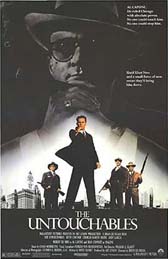 Brian De Palma's The Untouchables will screen twice on Tuesday, April 14-- at 1pm and 7pm at the Elk Grove Theatre (sometimes referred to as the Elk Grove Cinema). This is a Chicago Film Critics Association special event, and will be hosted by Peter Sobczynski, who will also lead a post-film discussion. De Palma is Sobczynski's favorite director, so it should be lively.
Brian De Palma's The Untouchables will screen twice on Tuesday, April 14-- at 1pm and 7pm at the Elk Grove Theatre (sometimes referred to as the Elk Grove Cinema). This is a Chicago Film Critics Association special event, and will be hosted by Peter Sobczynski, who will also lead a post-film discussion. De Palma is Sobczynski's favorite director, so it should be lively.
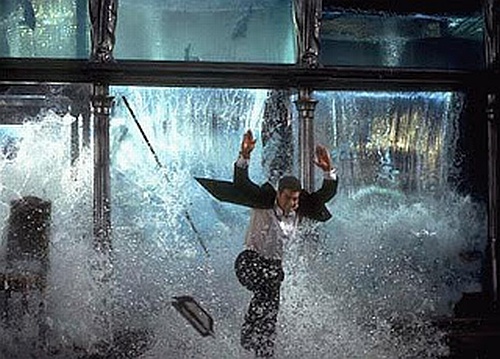 Vulture's Bilge Ebiri interviewed a veteran stuntman to get his take on Tom Cruise's "ten greatest stunts"-- and the top two are from Brian De Palma's Mission: Impossible. Here's Ebiri's introduction, and the stuntman's reviews of the top two stunts:
Vulture's Bilge Ebiri interviewed a veteran stuntman to get his take on Tom Cruise's "ten greatest stunts"-- and the top two are from Brian De Palma's Mission: Impossible. Here's Ebiri's introduction, and the stuntman's reviews of the top two stunts:When the trailer for the new Mission: Impossible film landed last month, it seemed all anybody could talk about was the stunt of Tom Cruise hanging off an airplane. And with good reason — ever since the first Mission: Impossible movie, Tom Cruise films have featured more and more daring stunts, often performed by the actor himself. Impressive stuff, to be sure. But what do real stuntmen think of Tom Cruise’s stunts? To get a professional’s opinion, we turned to Randy Butcher, a veteran Canadian stuntman, stunt coordinator, and director who is currently the stunt coordinator for Orphan Black and has worked on a variety of films, including X-Men, Dawn of the Dead, K-19: The Widowmaker, and countless others. He took a look at some of Cruise’s best-known and most impressive stunts, and offered his take on how they might have been done — and whether that really is Tom Cruise doing those stunts.1. Mission: Impossible (1996): Breaking into Langley, suspended on a wire.
Butcher: This is the wire gag that everybody copied forever. I’ve personally copied it myself. That’s Tom, hands down. It’s a pretty contrived scene, but I was on the edge of my seat. He’s in a harness, and they’re using some Spectra Rope, which is better than cable. Whether it’s 30 or 40 feet, Tom is absolutely in that harness, using his own stomach muscles and his own balance to maintain that position and that shot. They don’t cut away from it at all.
The fact that we can always see that it’s Tom really helps make the scene. There’s a profile shot of him over the computer, and you can actually sense his struggle to maintain that balance, which really adds to it. I know it’s not cool to like Tom Cruise anymore, but I’m a fan of his. I think he’s an underrated actor. His physical mannerisms complement what’s happening inside his mind. I like watching him act.
2. Mission: Impossible (1996): Fleeing as a giant fish tank explodes behind him.
Butcher: I’ve done stuff similar to this. They have a build, they fill it with water, and the special-effects team goes through a great deal of trouble to place detonation devices on that glass. If memory serves, in the scene, Tom Cruise sticks some kind of explosive on the glass. And there’s a guy standing in front of it. And that guy is jerked backwards on a cable, which is taken out in post, of course. If you have the opportunity to watch this scene frame by frame, watch the top of the glass before the guy gets jerked through. As he rises into the air, they cut to the opposite side of the glass that he’s going to come through. And if you look closely, you will see that at the top of the glass is a little hole that breaks first — that’s where the cable is going through. They’ve probably cut a hole in the glass, fed the cable through it to his harness, then, on action, he’s jerked backwards, probably from an air ratchet. And as he blows through, special effects create that spider effect that completely shatters the tempered glass.
And once he’s come blasting through, he’s opened up this huge, empty space in front of this tank for Tom Cruise to come through. And if you watch, you’ll see that Tom is at first behind a pillar. So he was out of harm’s way when they jerked the guy through. Once the glass is blown through, he comes out from behind that pillar and runs through the scene, towards [the] camera. I would have personally no issue at all putting an actor in that spot. I have no doubt that that’s Tom Cruise. (I’m pretty sure that that’s not live fish in there, though.) His only danger is that when this glass does blow, some of the broken glass will be carried along by the water, but not at any speed that would turn it into a projectile and potentially harm Tom. Plus, the lens has compressed the distance so much that he could be quite far away and you wouldn’t necessarily know it.
On the TV series Orphan Black, I just put an actor through a window. I had a stunt double there, and the actor and I had a chat. He was into doing it, but the producers weren’t because it was the first shot of the day and we had to shoot in sequence because of the way this apartment was going to be destroyed. But I designed how to do it so this guy wouldn’t be harmed. I needed him to go through, but I didn’t need to drag him back — that’s where the danger would have been. And he did it. So we had his face coming through the glass, and not the back of the stunt guy’s head. And I can’t begin to tell you what a big difference that makes, to be able to see the actor’s face in a situation like that.
Mendelson continues, "Yes, I am aware that GoldenEye was actually the 18th 007 adventure. But for all intents-and-purposes, Pierce Brosnan’s entry into the franchise, which came six years after the box office failure of License to Kill left the franchise’s long term future in doubt, was something of a soft reboot back before Hollywood felt the need to retell the origin story every friggin time. Anyway, the initial teaser trailer announced that James Bond was back in movie theaters during the summer of 1995 (attached to Species) showed off Pierce Brosnan in a tuxedo, and then dove headfirst into a 50-second montage of nonstop action and excitement, offering nary a hint of voiceover, plot, or even much in the way of narrative coherence. It was arguably the first trailer to move so quickly that you could barely digest the images.
"That’s not a criticism, but it was edited within an inch of its life and made the conventional action movie trailer, full of voiceover exposition, explicit plot points, and long take action sequences, feel downright slug-like by comparison. The James Bond franchise had one shot to reclaim its hold on the popular zeitgeist and make a case for its continued relevance in a world with Die Hard and Batman, and it wasn’t going to take any chances by coming up for air. And it was perhaps the most action-packed and relentlessly breathless action movie trailer you had ever seen. The next prime example of this somewhat new form of trailer construction came not with the second GoldenEye trailer (which was a conventional 1990′s sell with voice over and copious plot reveals), but rather the initial two teasers for Brian De Palma’s Mission: Impossible.
"What did audiences need to know about the Paramount release, which at the time was pegged to be the biggest grossing film of the summer (it sounds crazy now, but ID4 was not considered a sure thing even as late as June of 1996) other than that it was an adaptation of the popular ensemble spy action show and that it starred Tom Cruise? Nothing, which is what Paramount’s marketing department gave them outside of those two facts. The initial Mission: Impossible teaser dropped in late 1995 and didn’t even bother with a single line of dialogue, voice over or otherwise. They merely gave us 55 seconds of Tom Cruise and friends engaged in non-stop action set to Lalo Schifrin’s classic theme song culminating in that climactic 'Cruise flies off an exploding helicopter onto a train' bit that was one of the coolest things you had ever seen back then. That final shot of Cruise leaping from the exploding helicopter was the best money shot in a trailer I had ever seen. But upon seeing the film, my heart sank as I realized that golden money shot was actually the climactic death of the primary villain.
"So yes, I’ve been complaining about studios giving away the action finales of their films in the trailers for at least twenty years.
"The next trailer offered little-to-no plot beyond the introductory 'this is your mission' set-up and merely cryptic lines ('a simple game…') to power along what was basically 80 seconds of context-free action and just enough quotable dialogue to allow us to catch a moment’s breath. Ironically, if I may digress for a bit, it now exists as a classic example of both misdirection and spoiler-by-insinuation. If you actually pay attention to the trailer, you’ll see pretty much every major action moment in the film, which in turn makes the film appear to be far more action-drenched than it actually is. It falsely sets up Emmanuelle Béart as a damsel-in-distress spoiling not every action moment in the film but also quite a bit of the narrative. But I digress, the initial teasers for GoldenEye and Mission: Impossible were designed to be seen a few times in a theater, but they were also tailor made for the Internet, which was in its mainstream infancy."
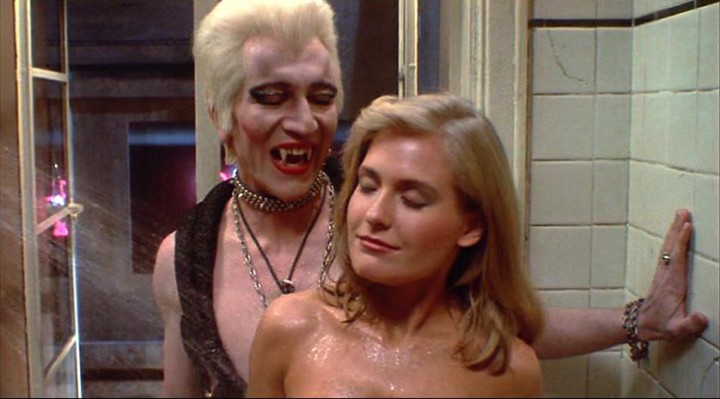
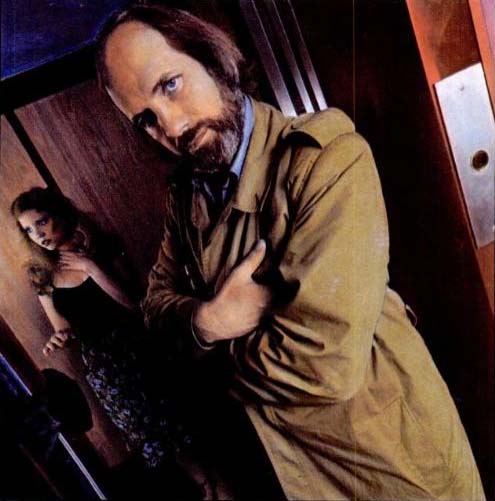 I just have a couple more notes regarding the Junk Food Dinner podcast I linked to the other day in a post about Sisters. The guys on the podcast also talked about Dressed To Kill, and as I mentioned the other day, sometimes the discussion is rather frustrating. For instance, one of them talks about the character Betty Luce, the female officer that Detective Marino has tailing Liz, and who, by outward appearances, looks just like Bobbi. One podcaster talks about how Betty Luce is, like Bobbi, transexual or transgender, but this is simply not the case. The podcast gets more frustrating as not one, but two more of the participants echo this mistaken perception of the character.
I just have a couple more notes regarding the Junk Food Dinner podcast I linked to the other day in a post about Sisters. The guys on the podcast also talked about Dressed To Kill, and as I mentioned the other day, sometimes the discussion is rather frustrating. For instance, one of them talks about the character Betty Luce, the female officer that Detective Marino has tailing Liz, and who, by outward appearances, looks just like Bobbi. One podcaster talks about how Betty Luce is, like Bobbi, transexual or transgender, but this is simply not the case. The podcast gets more frustrating as not one, but two more of the participants echo this mistaken perception of the character.Peter: Mom, this is the most incredible thing that I’ve ever built. I mean this carries!
Kate: [Humoring him] It carries… Carries what?
Peter: Binary numbers. I mean, it can hold up to a twenty-digit figure.
Kate: Now, wait a second [humoring him]—you said it can carry, and it holds, too?
Peter: [Nodding] Both, it does both, that’s the whole point. I mean, there isn’t a circuit like this in any of my books. I’ve invented it!
Kate: [Sincerely proud] Well, that’s great. That’s great, Peter.
I'm not sure what there is to complain about there, but the podcaster said that because he knows about De Palma's science background, "I expect better from De Palma."
At the beginning of an article by New York Magazine's David Rosenthal (August 4 1980, pp. 25-27-- the photo above is from the article), De Palma says, "That character in Dressed To Kill is me. I mean, that's my room. That machine, I built that machine. It was a differential analyzer."
 This is a little old, but two issues ago (from this past December), Fangoria #338 included a new interview with Margot Kidder, in which Lee Gambin asked her about three key horror films she made in the 1970s: Sisters, Black Christmas, and The Amityville Horror. Here is the excerpt regarding Sisters:
This is a little old, but two issues ago (from this past December), Fangoria #338 included a new interview with Margot Kidder, in which Lee Gambin asked her about three key horror films she made in the 1970s: Sisters, Black Christmas, and The Amityville Horror. Here is the excerpt regarding Sisters:FANG: Can you discuss your career during the years leading up to Sisters?
KIDDER: I was very young, and working nonstop. I started acting professionally in Montreal and Toronto, then moved to Hollywood at 18 with a couple of hundred bucks on me and a heart full of hope. I was very young and naive and thought, "Well, of course I'll get roles; I mean, I deserve it!" I landed a part in a Norman Jewison film [Gaily, Gaily], did a lot of low-budget movies and TV and then met Brian De Palma, who was one of those people making interesting independent movies. He loved Alfred Hitchcock-- you can see that in his work-- and he and I started seeing each other romantically.
FANG: What did you initially think of the story of Sisters?
KIDDER: Brian told me he wrote Sisters specifically for me. When he said that, I had to laugh: You thought of me to play this woman who castrates men after making love to them?! Well, ain't that nice! But I loved it. On Christmas morning, Brian came downstairs with the script, handed it to me and said, "There's your Christmas present." Then we went off and made the movie, and it was a lot of fun. It was one of his very early films; the money for it came from his mom, who owned a toy shop, and it was a wonderful time to make movies and a wonderful time to be young.
FANG: What was De Palma like as a director, and what was the most influential advice he ever gave?
KIDDER: Brian being my boyfriend didn't at all influence the way he directed me. I think his main brilliance is his true understanding of actors and what they can bring to a film. It truly is a joy working with him, and it shows in all of his movies; he just has that knack for tapping into something completely honest and real. Some of the younger directors these days agonize over getting those wonderful shots that were mastered by the likes of Brian and his friend Martin Scorsese, but what they don't get is that Brian and Marty are also extremely clued in to the fine art of working with actors, not just telling them where their marks are and whatever.
FANG: Was De Palma precious about his screenplay? Did he let you ad-lib at all?
KIDDER: There is one major secret about Brian that many people just aren't aware of, which is that he is one of the funniest people I know! He loved to inject his scripts with strong humor that played nicely along with the horror or suspense. He was always adament about what he wanted and why he wanted it, and if you thought of changing it or altering the words or whatever, you'd better also have a great reason to back it up. The character in Sisters I played was supposed to be Swedish, but I couldn't do a Swedish accent! I tried learning it, but it was just too hard, so I said, "Brian, can we make her French?" I grew up partly in Quebec so I was always around French-Canadians, and Brian was cool with that. His response was, "Fine. I just want her to be foreign."
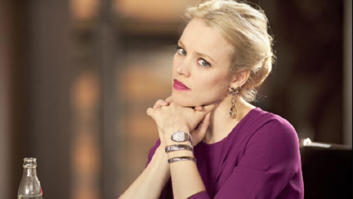 Last week, a trailer for the upcoming Antoine Fuqua film Southpaw, starring Jake Gyllenhaal, hit the web. "If you saw the trailer," states Forbes' Scott Mendelson, "you probably noticed Rachel McAdams as the 'girl' in the picture. Actually, that’s not entirely accurate, as she gets killed in the first third of the trailer, which in turn sends Gyllenhaal into a downward spiral. There was a moment ten years ago when she seemed primed to be the next big female movie star. But now she gets 'fridged' in male-centric melodramas and gets to be 'the girl cop' in True Detective season 2, which is quickly becoming something of a career rehab home for former movie stars and would-be movie stars who never quite made the sell. I have written so very much about the lack of female-led multiplex releases over the last decade or so, and I have long believed would-be 'It Girl' McAdams to be among its primary victims. You can’t be the next great movie star when Hollywood isn’t making movies for you to star in."
Last week, a trailer for the upcoming Antoine Fuqua film Southpaw, starring Jake Gyllenhaal, hit the web. "If you saw the trailer," states Forbes' Scott Mendelson, "you probably noticed Rachel McAdams as the 'girl' in the picture. Actually, that’s not entirely accurate, as she gets killed in the first third of the trailer, which in turn sends Gyllenhaal into a downward spiral. There was a moment ten years ago when she seemed primed to be the next big female movie star. But now she gets 'fridged' in male-centric melodramas and gets to be 'the girl cop' in True Detective season 2, which is quickly becoming something of a career rehab home for former movie stars and would-be movie stars who never quite made the sell. I have written so very much about the lack of female-led multiplex releases over the last decade or so, and I have long believed would-be 'It Girl' McAdams to be among its primary victims. You can’t be the next great movie star when Hollywood isn’t making movies for you to star in.""Rachel McAdams had the bad luck to spring to stardom just as the so-called female-centric studio release was becoming something of an endangered species. She of course came to fame in 2004 and 2005 with a flurry of high profile vehicles. She was, in 2004, a defining villain in Mean Girls and the co-lead in the generational romantic drama classic The Notebook. She had three major roles in 2005, including the heroic lead in Wes Craven’s Red Eye, a supporting role in the Sarah Jessica Parker-led ensemble The Family Stone, and the 'prize to be won' romantic interest in New Line Cinema/Time Warner Inc.’s Owen Wilson/Vince Vaughn comedy smash The Wedding Crashers. Take one guess which role would come to define the next decade of would-be stardom. She took a break from acting for a couple years and returned in two low-budget independent films. Married Life was a martial fidelity drama starring Pierce Brosnan, Chris Cooper, Patricia Clarkson, and McAdams as the would-be temptress. The Lucky Ones (Lions Gate Entertainment) was an underrated and little-seen drama co-starring Tim Robbins and Michael Pena about three Iraq war vets adjusting to life after service.
"She returned to so-called mainstream movies in 2009 and it is at this point the pattern began to emerge. By 2008/2009 we were seeing a real lack of not just female-centric films but movies that required more than one role for a woman matching McAdams’s respective gender and/or age. She is a young blogger journalist in the (terrific) Russell Crowe/Ben Affleck/Helen Mirren/Robin Wright thriller State of Play (Universal) who exists mostly to be schooled on the purity of old-school journalism and she was 'the girl' in Guy Ritchie’s Sherlock Holmes for Warner Bros. She reprised that role in a glorified cameo for Sherlock Holmes: A Game of Shadows, because the film didn’t have room for two major female roles and Noomi Rapace taking that slot this time. She was the co-lead in The Time Traveler’s Wife in 2009 (even though for all intents-and-purposes it is Eric Bana’s story) and she co-starred as a memory-impaired young spouse alongside Channing Tatum in The Vow. She did have a genuine lead vehicle in 2010, starring as an ambitious morning show producer trying to work with Harrison Ford’s cantankerous news vet in Morning Glory.
"And aside from Brian De Palma’s blink-and-you-miss it 2013 erotic indie drama with Noomi Rapace entitled Passion, that’s it for lead roles or even arguably co-starring roles for Ms. McAdams. She played the girl-to-be-discarded in Woody Allen’s Midnight In Paris and one of Ben Affleck’s handful of would-be love interests Terrence Malick’s To the Wonder, played 'the girl' in the father/son time-travel drama About Time, and was basically the only woman in an otherwise male-centric ensemble in A Most Wanted Man, which was notable for being Philip Seymour Hoffman’s final starring role. [Editor's note: this description really gives short shrift to that film's other distinguished female turns from Nina Hoss and Robin Wright.] Her output for 2015 involves being the one woman in a sea of dudes (Mark Ruffalo, Michael Keaton, Liev Schreiber, Stanley Tucci, John Slattery, and Billy Crudup) in the 'Boston Globe investigates Catholic Church sex scandals' drama Spotlight, being the married former lover of star Bradley Cooper as he also 'bonds' with Emma Stone in Cameron Crowe’s Aloha for Sony, and the aforementioned 'gets accidentally shot so Jake Gyllenhaal can have a sad' role in Southpaw. Oh, and she’s also in the cast of True Detective season 2 as the lone female cop in a cast that includes Vince Vaughn, Colin Farrell, and Taylor Kitsch.
"The vast majority of McAdams’s mainstream roles in her post-stardom career have been 'the girl' in an otherwise male-dominated cast. That is arguably because that was becoming even more of the so-called status-quo right as she was becoming a would-be movie star. Her relative lack of mainstream starring vehicles is mostly due to the fact that so few female-centric star vehicles get made in Hollywood anymore. There are few female-centric films that get made in Hollywood, especially the kind of somewhat melodramatic dramas or thrillers that used to give someone like Ashley Judd a career. The kind of mainstream films, be they romantic comedies, family melodramas, and everything in-between, that once starred Julia Roberts and Sandra Bullock are all-but-extinct in modern Hollywood. The Hollywood of the 1990′s had room for Meg Ryan vehicles, Sandra Bullock vehicles, and Julia Roberts vehicles with room to spare. They were romantic comedies like French Kiss, family melodramas like Something to Talk About, or even supernatural comedies like Practical Magic. Those films don’t get made anymore, to the point where now even something like a female-driven romantic comedy like Amy Schumer’s Trainwreck is considered a 'big deal.' [Once] you age out of the young-adult literary adaptations and/or the newest live-action adaptation of a Walt Disney animated feature, you’re basically stuck playing 'the girl.' And just as importantly, the male-centric films that do get made usually have room for just one or two major female roles in the cast."
AS 'MAD MEN' WINDS DOWN, CHERNOV SUGGESTS THE 12 GREATEST ADVERTISING MOVIES
At Agency Post, Matthew Chernov (who a couple of weeks ago included Dressed To Kill's Liz Blake on his "12 Hookers with Hearts of Gold" list for Variety), anticipating the final season of AMC's Mad Men, yesterday posted "The 12 Greatest Advertising Movies Ever Made," or "a list of 12 movies that could teach Don Draper a few things about the business." Included on his list is De Palma's Passion. "Brian De Palma’s welcome return to the erotic thriller genre is actually two movies in one" states Chernov. "The first is a stylish black comedy about advertising executives stabbing each other in the back to get ahead. The second is a surreal horror film about a masked psycho slashing necks to get revenge. Swedish sphinx Noomi Rapace plays a mousy copywriter whose conniving boss steals credit for her viral ad campaign, setting in motion a gruesome string of murders. As the body count rises, Passion proves that advertising can be a cut-throat business."
Also included on the list is Robert Downey Sr.'s Putney Swope. Chernov writes, "Robert Downey Sr. wrote and directed this counterculture satire about a lone black man on the executive board of an advertising firm who’s accidentally put in charge by the white members during a secret election. Renaming the agency 'Truth and Soul, Inc.' the new chairman fires his fellow board members and institutes a policy forbidding them to accept business from companies that manufacture alcohol, tobacco and war toys. Eventually, the U.S. Government takes notice and declares the firm a threat to national security. Shot in black and white, the outrageous TV commercials seen throughout the movie appear in color."
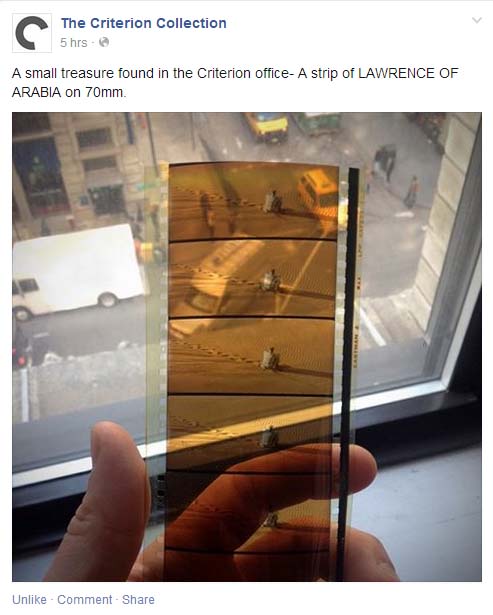 The Criterion Collection posted this photo on its Facebook page today, showing someone holding up a film strip from David Lean's Lawrence Of Arabia. It reminded me of Brian De Palma talking about the formation of the ideas that led to Blow Out. And it seems rather timely, after yesterday's post of audio between De Palma and Noah Baumbach, to post the following link and excerpt from someone who saw and heard Baumbach introduce a screening of Blow Out as part of BAMcinématek's De Palma retrospective in 2011 (it was around this time that De Palma's film was released as part of the Criterion Collection, and included, as one of its bonus features, Baumbach interviewing De Palma about the film).
The Criterion Collection posted this photo on its Facebook page today, showing someone holding up a film strip from David Lean's Lawrence Of Arabia. It reminded me of Brian De Palma talking about the formation of the ideas that led to Blow Out. And it seems rather timely, after yesterday's post of audio between De Palma and Noah Baumbach, to post the following link and excerpt from someone who saw and heard Baumbach introduce a screening of Blow Out as part of BAMcinématek's De Palma retrospective in 2011 (it was around this time that De Palma's film was released as part of the Criterion Collection, and included, as one of its bonus features, Baumbach interviewing De Palma about the film).
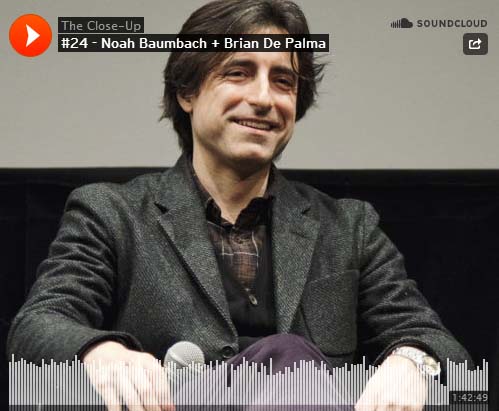 At the 2012 New York Film Festival, Brian De Palma and Noah Baumbach appeared on stage together, along with moderator Scott Foundas, to discuss their films. That discussion was summarized at the time by The Playlist's Cory Everett, and video clips have been posted to YouTube, but now we have full audio of the on-stage discussion, presented along with Baumbach discussing his new film, While We're Young. The new discussion is first, as it has been posted as a promotional item for Baumbach's new movie, and then the second part is the Baumbach/De Palma discussion. I cannot embed the audio here, but you can play it and listen on SoundCloud.
At the 2012 New York Film Festival, Brian De Palma and Noah Baumbach appeared on stage together, along with moderator Scott Foundas, to discuss their films. That discussion was summarized at the time by The Playlist's Cory Everett, and video clips have been posted to YouTube, but now we have full audio of the on-stage discussion, presented along with Baumbach discussing his new film, While We're Young. The new discussion is first, as it has been posted as a promotional item for Baumbach's new movie, and then the second part is the Baumbach/De Palma discussion. I cannot embed the audio here, but you can play it and listen on SoundCloud.
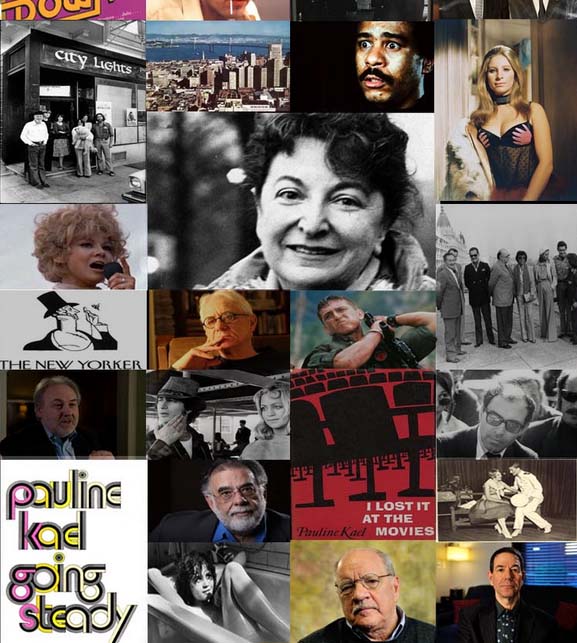 The collage at left is cropped from the home page for the movie What She Said: The Art Of Pauline Kael. It includes an image of Sean Penn from Brian De Palma's Casualties Of War in the center area, right underneath the central image of Kael's face. Paul Schrader, who is one of several filmmakers and others interviewed for the movie, appears at the bottom. You can scroll down that page to watch a five-minute trailer for the movie, which is still being made, or you can watch it on Vimeo.
The collage at left is cropped from the home page for the movie What She Said: The Art Of Pauline Kael. It includes an image of Sean Penn from Brian De Palma's Casualties Of War in the center area, right underneath the central image of Kael's face. Paul Schrader, who is one of several filmmakers and others interviewed for the movie, appears at the bottom. You can scroll down that page to watch a five-minute trailer for the movie, which is still being made, or you can watch it on Vimeo.